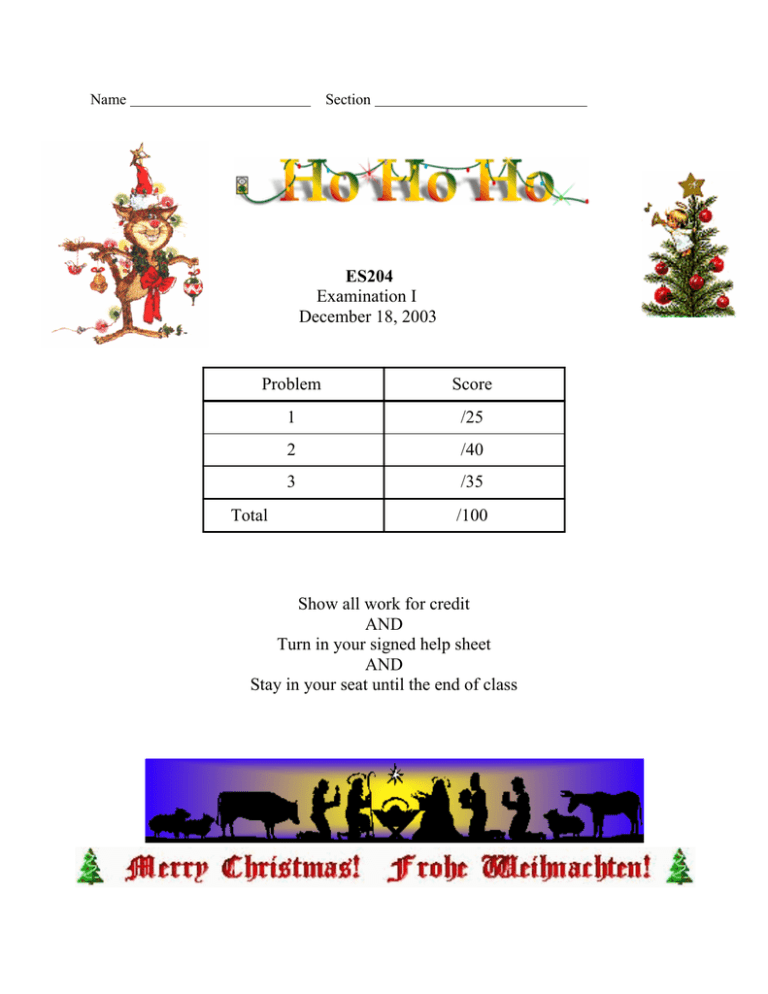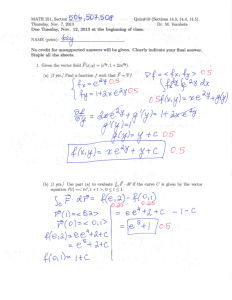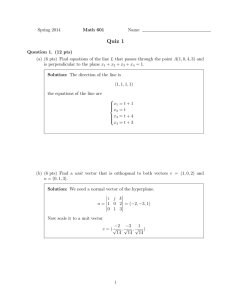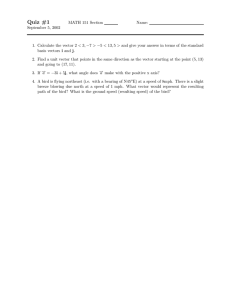Examination I December 18, 2003 Problem Score
advertisement

Name Section ES204 Examination I December 18, 2003 Problem Score 1 /25 2 /40 3 /35 Total /100 Show all work for credit AND Turn in your signed help sheet AND Stay in your seat until the end of class Name ES204 Examination I 25 pts Dec. 18, 2003 Problem 1 1.1) An aircraft flies in a perfectly circular path at constant altitude as it awaits clearance to land. What is true about the normal-tangential coordinate system and the polar coordinate system (with origin at the center of the circular path) associated with the aircraft motion? Top View a. The normal unit vector e n and the radial unit vector e r are perpendicular. b. The radial unit vector e r and the tangential unit vector e t are parallel. c. The magnitudes of the rates of change for the normal unit vector e n and the transverse unit vector e θ are different. d. The normal unit vector e n and the radial unit vector e r point in opposite directions. 1.2) Blocks A and B are released from rest. Assume the friction between A and B and between A and the ground is zero. Which figure below best indicates the direction of the acceleration of block B? a) aB b) c) d) α>θ α=θ aB aB B aB e) α<θ aB frictionless θ A 1.3) The table shown below starts from rest and speeds up so that the block experience a constant tangential acceleration, at. Assume the block does not slip on the table. What is the direction of the friction force when the speed of the block is, v? Circle the direction the best shows the direction of the friction force. Top View 1.4) The velocity of Block A is 1 m/s down. What is the velocity of block B? (Show all work for partial credit) a) 1 m/s up b) 2 m/s up c) 3 m/s up d) 4 m/s up e) none of the above A B 1.5) A police officer, A, is driving towards an intersection at 30 mph. He determines that the speed of car B with respect to the police car is 50 mph. What is the actual speed of the car? a) 20 mph b) 40 mph c) 80 mph d) not enough information given e) none of the above B vB 30 mph A Name ES204 Examination I 40 pts Dec. 18, 2003 Problem 2 Block A slides down the incline and strikes sphere B causing it to swing up. The tension in the cable is 100 N immediately after the impact. Assuming the mass of A, mA, the mass of B, mB, the coefficient of restitution, e, the coefficient of friction, µk, and the distance, d, are all known, determine the equations necessary to determine the initial velocity of A, vo. Neglect the friction between A and B during the impact. vo L A µk 20° DO NOT SOLVE THE RESULTING EQUATIONS! Your solution should consist of a table of unknowns/equations and a numbered collection of equations. B d Unknowns Equation Number Name ES204 Examination I 35 pts Dec. 18, 2003 Problem 3 When θ = 150° and r = 2 ft it was noted that the 0.5 lb collar sliding on the rod shown was traveling with respect to the rod away from the pivot point at 5 ft/s and increasing at 1.02 ft/s2. The rod’s angle is increasing at a rate of 0.1 rad/s counterclockwise and it is slowing down at 2 rad/s2. When θ = 150° determine the: a) collar velocity b) collar acceleration c) the magnitude of the normal force of the collar acting on the rod A r O B θ Top View


